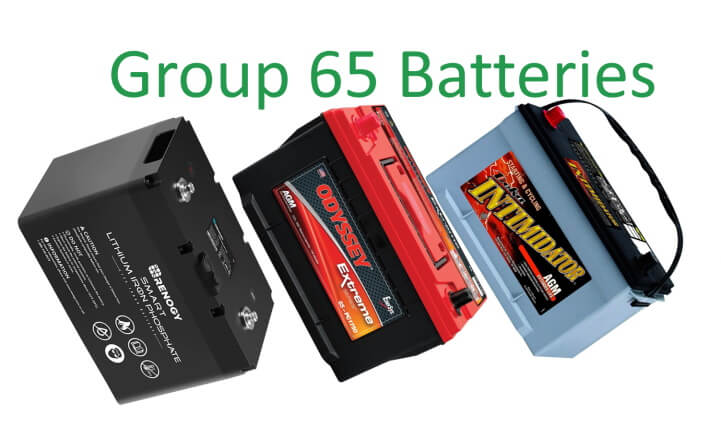Published on: May 6, 2022
Written by Liam Jaxon / Fact-checked by David Rowan
Group 65 batteries are a typical BCI size. You’ve arrived at the perfect site if you use a car, boat and industrial machine that requires the group 65 batteries. Because of their versatility and dependability, these batteries are often utilized as automobile, marine, and industrial batteries. Three types of group 65 batteries are available:
- A thick plate deep cycle battery;
- A thin plate stop/start battery;
- A dual-purpose combination.

According to industry standards, these batteries will have an amp hour (Ah) capacity between 70 to 75 Ah and a cold cranking amp (CCA) capacity between 700 to 930 CCA. Also, it has a reserve capacity of 120 to 150 RC. If you are not sure whether you need a group 65 battery depending on the sizes and usage, you can acknowledge the battery group size chart here.
A group 65 battery is a common off-grid battery. With this battery, the engine may be started, stopped, and operated continuously without losing charge. Keep reading this article to acknowledge some more information with a comparison chart and our recommendations until the end.
What Is a Group Size 65 Battery?
It is crucial to understand what a group size 65 battery is before you opt for one. Most group 65 batteries are 11.85 x 7.30 x 7.40 inches, so measure your space before buying.
The group 65 batteries have a larger reserve capacity than other batteries. The battery’s remaining power before it drops below the necessary voltage. This feature ensures that the battery won’t die or malfunction when you’re driving on the highway.
So the next time you’re taking a lengthy car drive and listening to the radio, you won’t have to be concerned about how long a car battery lasts with the radio on will remain. The best performance is achieved in selected car types that accept group 65 batteries.
Features of Group 65 Batteries
Other batteries may fail, but these trustworthy batteries will continue to work. Below are the features:
1) Consistent Capacity
Most of the Group 65 batteries can last up to 25 hours. These 70-75 Ah batteries are built to last in the harshest environments. The discharge time affects battery capacity. The actual capacity decreases as the discharge time decreases.
2) Large Reserve
The average reserve capacity is 120 to 150 minutes. Lithium-ion batteries are meant to last longer; therefore, they may have 200 minutes or more backup capacity time before the battery dies.
3) Weight
Lithium-ion batteries are considerably lighter and more adaptable. A group 65 battery weighs between 45 to 55 pounds which makes transportation easy. They also have sturdy handles for easy movement.
4) AGM Technology
The AGM technology prevents leakage of its contents. The liquid electrolyte can’t spill even if the container is accidentally placed upside-down on the counter. The battery requires no maintenance and is highly convenient to use. There is no monitoring or replenishment of its contents by AGM technology.
5) Safe and Convenient
The battery is entirely safe to use because it does not emit harmful gases such as hydrogen when charging. It is vibration-resistant, which extends its useful life. Due to the battery’s CCA, it will continue to operate at low temperatures. It does not freeze in extreme cold.
Different Types of Group 65 Batteries
Group 65 batteries, like other industrial and automotive batteries, are either manufactured using the Absorbent Glass Mat (AGM) technology or are Sealed Lead-Acid (SLA) batteries.
When it comes to heavy-duty applications, AGM batteries are preferable, like Deka 9A65 AGM Intimidator Battery. There is no need to clean the batteries, and there is no possibility of corrosion, which could compromise the battery’s performance.
AGM batteries are more expensive than sealed lead-acid batteries. They are, however, nevertheless intended to give outstanding power output, despite their size and weight. One of the popular lead-acid batteries is ODYSSEY 65-PC1750T.
In order to ensure that the battery lasts for an extended period, high-quality SLA batteries will incorporate spill-resistance properties. Some people prefer lithium-ion 65 batteries, such as Renogy 12V, which are less common but still available in limited quantities.
Difference Between Other Batteries With Group 65
If you know the difference in battery group sizes, it will be easier to install a battery according to your vehicle size and need. Other batteries, such as Group 24 Batteries or Group 34 Batteries, are different sizes from the group 65 battery. They are either higher or less in diameter. Following the Battery Council International’s specifications, each battery group has a particular size.
As a result of the differences in CCA and CA, some batteries have a varied power rating. Based on the application, they may be larger or smaller than group 65 batteries. Apart from that, the reserve capacity and terminal position of group 65 batteries differ from those of other battery groups.
Recommendations of BCI Group 65
There are no set rules to decide what is the best group 65 battery. The batteries in Group 65 that are listed in the chart can be classified into numerous categories:
1) Batteries With a CCA Rating of 750-775 Amps
If you’re looking for a mid-range group 65 battery with 700 to 775 amps and at a fair price, go no further than the ACDelco Gold 65AGMHRC battery, which has better customer reviews. The battery ranges 70 Ah 20h, 775 CCA, 960 MCA, and a 150-minute RC rating. It weighs around 20.8 kg.
On the other hand, ODYSSEY 65-PC1750T provides the massive starting power, swift recovery, and incredible deep cycling capacity that automobiles require. It has a lot more plates than the previous film. The more plates you have, the more power you have, up to 400 cycles at 80% drain depth.
In addition to 75 Ah/20h capacity, the Delphi BU9065 weighs 21.5 kg and has a 750 CCA rating. Besides, the most popular Deka 9A65 battery has a capacity of 75 Ah/20h, 775 CCA, 955 MCA, and 150 min RC.
2) Batteries With a CCA Rating of 900+ Amps
There are very few groups of 65 batteries that touch over 900 amps. Among them, XS Power D6500 works well in real-life situations at very low temperatures with a CCA rating of 1050 Amps. The XS Power AGM batteries provide the best energy density of any AGM battery on the market.
3) Lithium-ion Battery With Long Rc Time and High Cycle Capacity
Renogy 12V LiFePO4 Deep Cycle Lithium Battery has a nominal voltage of 12.8 volts and a capacity of 100 Ah. The capacity of lithium-ion batteries declines with an increased discharge rate, but not as much as lead-acid capacity.
At 0.2C, 8000 charging/discharging cycles at 80% DoD or 7000 at 50% DoD are conceivable (20 Amps). Each battery is 3.2-3.3 V nominally, with a 3.5-3.6 V charging voltage maximum.
Comparison Chart
| Model | Battery Type | Cell Type | Ah | CCA | RC | Weight (lbs/kg) |
| ACDelco Gold 65AGMHRC | Dual Purpose | AGM | 70 | 775 | 150 | 20.8 kg |
| Deka 9A65 AGM | Dual Purpose | AGM | 75 | 775 | 150 | 20.85 kg |
| Delphi BU9065 | Dual Purpose | AGM | 75 | 750 | 150 | 21.5 kg |
| ODYSSEY 65-PC1750T | Dual Purpose | AGM | 74 | 950 | 145 | 54 lbs; 24.5 kg |
| Renogy RBT100LFP12S-G1 | Deep Cycle | Lithium | 100 | – | ~230 | 26 lbs; 11.8 kg |
| XS Power D6500 | Dual Purpose | AGM | 75 | – | 150 | 55.8 lbs; 25.3 kg |
Group 65 Battery Maintenance Tips
Battery maintenance is critical to extending the life of the battery; well-kept batteries outlast poorly managed batteries. The following are some helpful maintenance advice for group 65 batteries.
1) Always use a wire brush to clean the battery connector to ensure that no interruptions to the power supply occur.
2) When the car is not in use for an extended period, it is wise to disconnect the battery.
3) When disconnecting a battery, always begin with the negative terminal.
4) Avoid putting any metallic objects on the battery, particularly the terminals, since this could result in a short.
5) Maintain a healthy battery by starting and operating the vehicle regularly. Doing that twice a week for 25 minutes should suffice. The key is to charge the battery fully.
FAQs
What vehicles use a Group 65 battery?
Battery Group 65 is widely used in automobiles. But specifically, the performance of Dodge, Mercury, Lincoln, and Ford vehicles that use group 65 batteries will be noticeably better.
Is it possible to use a group 65 battery in the winter?
Definitely, the Group 65 battery is an excellent choice for cold weather. CCA rating is an indicator of how long the battery will last.
When not in use, how do I remove a group 65 battery?
When disconnecting a battery, always begin at the negative terminal first.
Final Verdict
The group 65 batteries will have a long life and be reliable. I hope that this instruction helps you change your batteries with confidence.
Your search for the most incredible group 65 battery is over now—no more hopping from battery to battery in quest of the perfect fit for your car demands. Always remember when making a purchase choice, consider your CCA, CA, and reserve capacity demands.
About This Writer

Hi, I am responsible for the 'Homeowners Power Solutions' category. My name is Liam Jaxon and a licensed technician with 7 years of experience in vehicle batteries, electrical gadgets, and home appliances. My working experience in different residential & light commercial electrical sectors and the automobile industry helped to acquire vast knowledge in this industry.